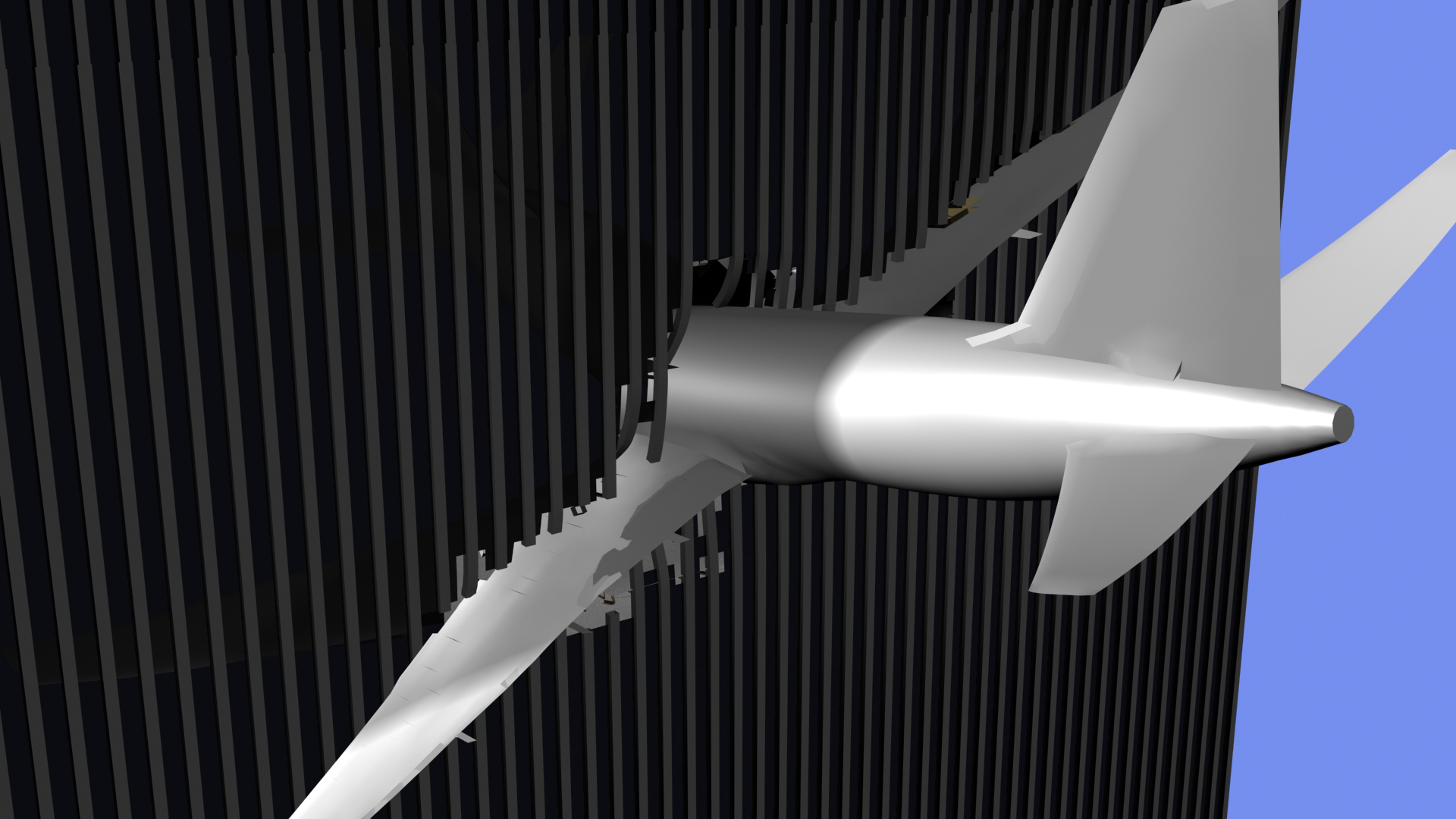Behind Purdue's computing simulation on the 2001 World Trade Center attack

Researchers at Purdue University have completed a computing simulation to detail what likely happened to the World Trade Center wh
Here's how Purdue describes the simulation results (see video):
The simulation depicts how a plane tore through several stories of the World Trade Center north tower within a half-second and found that the weight of the fuel acted like a flash flood of flaming liquid, knocking out essential structural columns within the building and removing fireproofing insulation from other support structures. The simulation used lines and dots to show the aircraft and building during the event.
To animate those lines and dots to make them more realistic, Voicu Popescu, an assistant professor of computer science, developed an application that creates a link between computer simulations and computer visualization systems. This translator program automatically translates simulation data into a 3-D animation scene. The goal is to make a simulation that's clear to non-expert users yet scientifically accurate.
As for the hardware, Purdue carried out the mathematical models to represent the building and airplane on the Regatta computer, an IBM system roughly equivalent to the combined power of 128 personal computers. The computer is operated by Information Technology at Purdue as part of the Network for Computational Nanotechnology, based at Purdue's Discovery Park and supported by the National Science Foundation. Other computations were delivered via the Northwest Indiana Computational Grid, a consortium of universities and government research labs.
Popescu's custom-built application made the simulation more realistic, but refrained from being too detailed so it wouldn't exploit the event. The overarching goal of the translator was to turn data into visual events.
Popescu's biggest beef was that typical simulations--like those seen on television news programs--are scientifically incorrect.
As for Popescu's application, Purdue provided a lengthy description that frankly I'll only screw up trying to excerpt. Here's the raw description in full:
Simulation codes and computing hardware are now sufficiently powerful to track with high fidelity complex interactions in large-scale digital models, shedding detailed insight into past or hypothetical real-world events. Visualization is an essential tool for collecting the information revealed by the simulation. Most simulation codes are enhanced with visualization modules which allow examining the simulation results visually. Such visualization modules excel at highlighting the quantities of highest relevance to the domain experts that designed the simulation, but they are typically quite limited when it comes to depicting the simulation results in a visual language accessible to the non-expert user. The post-processors called upon to visually render the simulation results are one or several steps behind the state-of-the-art in general purpose visualization.
This limitation is particularly severe when there is strong interest in the simulation beyond the narrow circle of experts that devised it. Such was the case for a high-fidelity simulation of the September 11 Attack on the World Trade Center developed by a Purdue University team of civil engineering and computer science researchers. Using detailed finite element analysis (FEA) models of the top twenty floors of the North Tower and of the airframe, the simulation tracks in great detail the impact over one second of real time. In order to overcome the post-processor’s general-purpose visualization limitations, the Purdue team developed a translator that automatically converts the simulation output data into a 3D scene amenable for high-quality visualization using a state-of-the-art animation system.
Driven by immensely popular entertainment applications such as 3D games and movies, animation systems define the state-of-the-art in computer graphics and general-purpose visualization. Although such animation systems do have simulation capabilities, precisely abiding by the laws of physics is of secondary importance compared to effective story-telling. Consequently, the approach of bridging the worlds of computer simulation and computer animation through a data translator allows combining the advantages of both worlds. A high-quality visualization is computed within the animation system while preserving the highest possible level of physical accuracy conferred by a rigorous state-of-the-art simulation code.
The translator implements two main tasks. First, simulation data with little visualization relevance is discarded. Examples include removing internal faces of structures modeled with opaque solid elements, discarding values of physical quantities not intended to be visualized, simplifying planar surfaces that are not affected by the simulation and are therefore excessively tessellated by finite elements, and removing intermediate positions for nodes with rectilinear and uniform motion.
The second task is to enhance or add detail that has high visual relevance but was only crudely approximated or even ignored due to its little simulation relevance. For example, once an element erodes, the simulation code simply eliminates it from subsequent computations. Assuming that the element breaks into many small fragments, eliminating the element is an acceptable approximation from the simulation standpoint, since the expense of tracking each fragment individually is not justified by the fragments’ impact on the simulation. Another example is adding the geometry needed to model the actual profile of a beam element. The simulation uses only two nodes and a normal per beam elements regardless of the beam profile (the shape is accounted for by physics equation in the FEA) but drawing all beam elements as segments is unacceptable. A third example is the addition of fire visualization. The simulation did not take into account the effects of the explosion and of the ensuing fire. The smoothed particle hydrodynamics (SPH) elements modeling the jet fuel are used by the translator to automatically control the fire visualization matching the dispersing fuel.
The resulting importer is a powerful, scalable, and general tool suitable for visualizing FEA simulations. Although the translator was developed in the context of the commercial simulation system LS-DYNA and the commercial animation system 3ds Max, the translator can be extended to support other pairs of simulation/animation systems. The visualizations produced achieve the dual goal of physical and visual fidelity, surpassing what can be produced with typical postprocessors, yet tracking the physical entities with the rigor if state-of-the-art simulation code.
Other links on the topic: